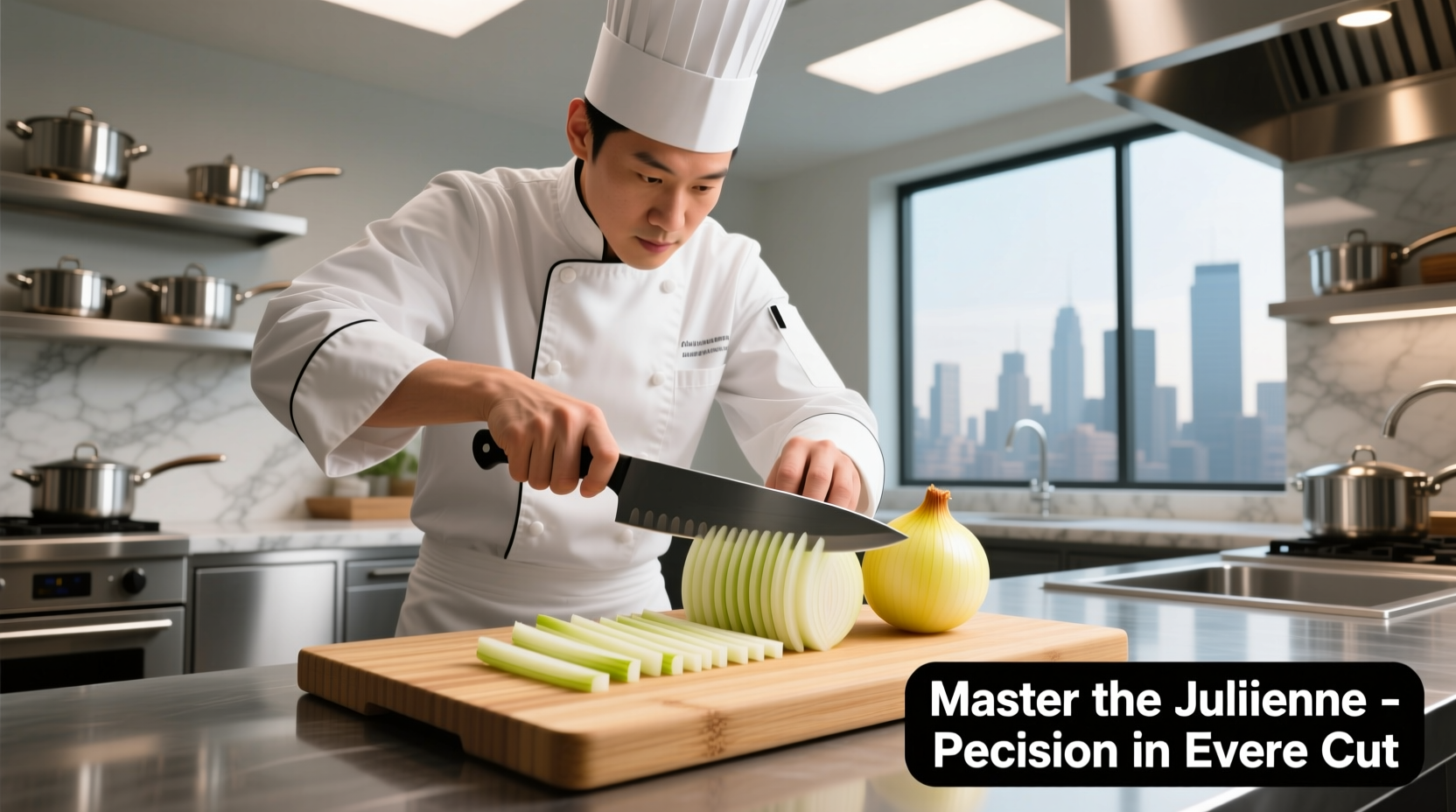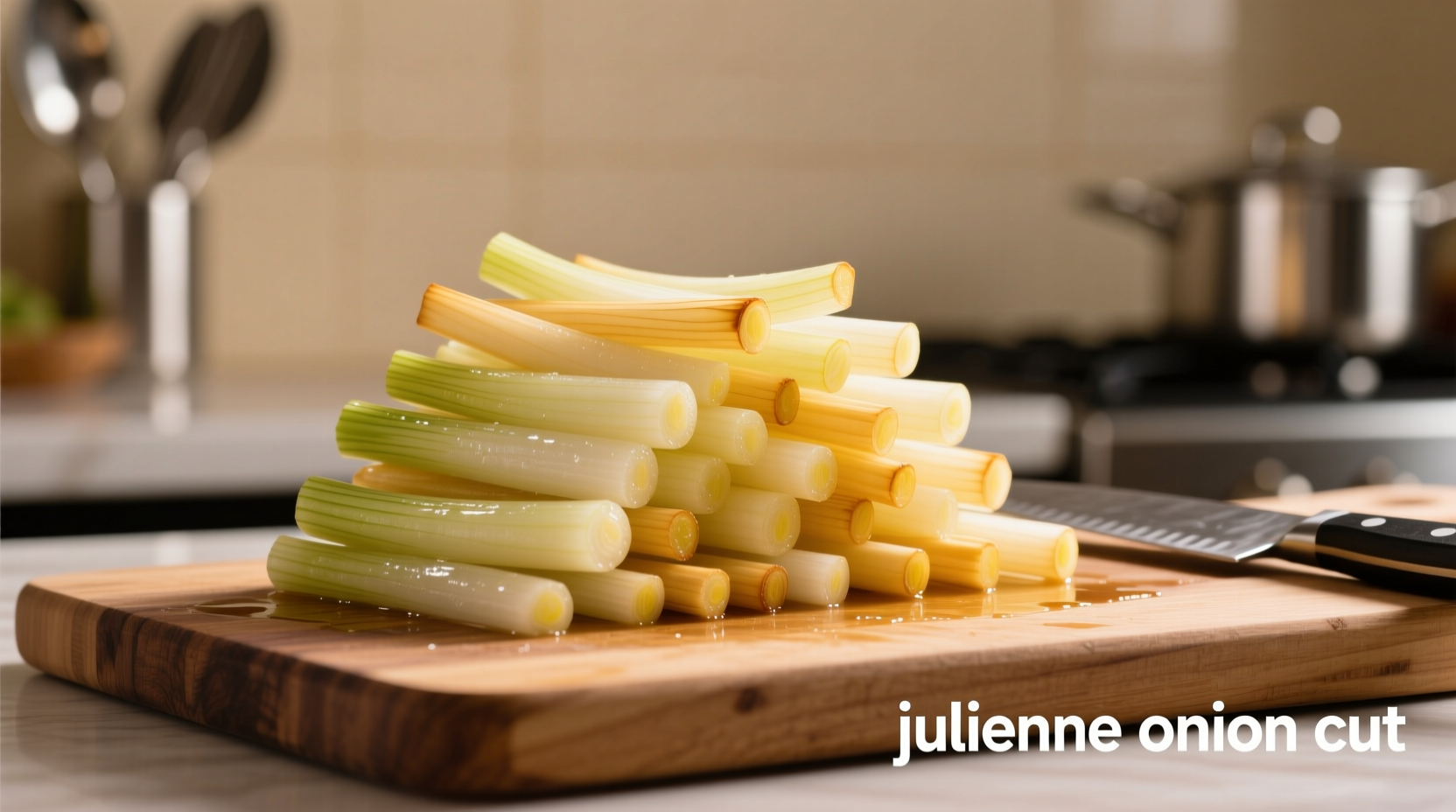Master the julienne onion cut technique to create uniform, matchstick-shaped onion strips measuring approximately 1/8 inch thick and 2 inches long—perfect for stir-fries, garnishes, and dishes requiring quick, even cooking.
Ever wonder why professional chefs' stir-fries look so picture-perfect while yours turn out uneven? The secret often lies in proper knife skills, particularly the julienne cut. This precise technique transforms onions into elegant, uniform matchsticks that cook evenly and elevate your dishes from home-cooked to restaurant-quality. In this guide, you'll learn exactly how to julienne onions like a pro, complete with step-by-step instructions, common mistakes to avoid, and the best culinary applications for this versatile cut.
What Exactly Is a Julienne Onion Cut?
A julienne cut refers to slicing ingredients into thin, matchstick-shaped pieces. For onions specifically, this means creating uniform strips approximately 1/8 inch thick and 2 inches long. Unlike a standard dice or rough chop, the julienne technique produces elegant, consistent pieces that cook evenly and add visual appeal to your dishes.
The term "julienne" originates from French culinary tradition, where precision cutting techniques were developed to ensure consistent cooking times and professional presentation. While commonly associated with vegetables like carrots and celery, the julienne cut works exceptionally well with onions when executed properly.

Julienne vs. Other Onion Cutting Techniques
Understanding the differences between cutting techniques helps you choose the right method for your culinary needs. Here's how julienne compares to other common onion cuts:
| Cutting Technique | Dimensions | Best Culinary Applications | Preparation Time |
|---|---|---|---|
| Julienne | 1/8" x 1/8" x 2" | Stir-fries, garnishes, salads, Asian cuisine | Moderate (requires precision) |
| Dice (Medium) | 1/4" cubes | Sauces, soups, stews, salsas | Quick |
| Minced | 1/8" pieces or smaller | Finishing touches, dressings, compound butters | Moderate |
| Wedges | Varies by onion size | Grilling, roasting, caramelizing | Quick |
Why Master the Julienne Onion Cut?
The julienne technique offers several culinary advantages that make it worth learning:
- Even cooking – Uniform pieces ensure all onion strips cook at the same rate, preventing some from burning while others remain raw
- Professional presentation – Creates elegant, restaurant-quality appearance in finished dishes
- Texture control – Provides the perfect balance between structural integrity and tenderness
- Flavor distribution – Allows for consistent flavor throughout your dish
- Quick cooking time – Thin strips cook rapidly, ideal for high-heat techniques like stir-frying
According to culinary research from the Culinary Institute of America, properly cut julienne onions increase surface area by approximately 40% compared to standard dicing, which significantly impacts both cooking time and flavor release in dishes.
Essential Tools for Perfect Julienne Onions
You don't need specialized equipment to julienne onions effectively. Here's what you'll need:
- Sharp chef's knife (8-10 inches) – A sharp blade is crucial for clean cuts and safety
- Cutting board – Preferably wood or plastic with non-slip base
- Bowl of ice water (optional) – Helps reduce tearing while cutting
- Damp kitchen towel – For securing cutting board
Professional chefs recommend using a knife with a comfortable grip that allows for proper pinch grip technique. The American Culinary Federation notes that a dull knife actually increases the risk of kitchen accidents by requiring more force during cutting.
Step-by-Step: How to Julienne an Onion Perfectly
Preparation Phase
- Chill the onion – Refrigerate for 30 minutes to reduce tearing compounds
- Trim properly – Cut off root end while preserving root structure for stability
- Slice in half – Cut vertically through the root end to create two equal halves
- Remove skin – Peel away outer layers while keeping onion intact
Cutting Technique
- Make horizontal cuts – With the flat side down, make 3-4 shallow horizontal cuts toward the root end without cutting all the way through
- Create vertical slices – Turn the onion and slice vertically at 1/8-inch intervals to create thin strips
- Final julienne cut – Rotate the onion 90 degrees and slice across at 1/8-inch intervals to create uniform matchsticks
- Separate pieces – Gently separate the julienne strips with your fingers
Avoid These Common Julienne Cutting Mistakes
Even experienced home cooks make these errors when attempting the julienne onion cut:
- Starting with a dull knife – Causes crushing rather than clean cuts, releasing more tear-inducing compounds
- Cutting all the way through during horizontal cuts – Results in uneven pieces and wasted onion
- Incorrect sizing – Making strips too thick defeats the purpose of the julienne technique
- Ignoring onion orientation – Cutting against the grain creates less stable pieces that fall apart during cooking
- Rushing the process – Proper julienne requires patience and precision for best results
Food safety experts at the USDA recommend always cutting away from your body and keeping fingers curled under while performing any knife work to prevent accidents.
Best Culinary Applications for Julienne Onions
The julienne cut shines in specific cooking applications where uniformity and quick cooking are essential:
- Stir-fries – Cooks evenly with other julienned vegetables without becoming mushy
- Garnishes – Adds elegant presentation to finished dishes
- Asian cuisine – Essential for dishes like spring rolls, pad thai, and Korean bibimbap
- Quick-pickled onions – Uniform size ensures consistent pickling
- Salads – Provides texture without overwhelming other ingredients
Professional chefs at Le Cordon Bleu note that julienne-cut onions work particularly well in high-heat cooking methods because their increased surface area allows for rapid caramelization while maintaining structural integrity.
When NOT to Use Julienne-Cut Onions
While versatile, the julienne technique isn't appropriate for every culinary situation. Avoid this cut when:
- Preparing soups or stews that require long simmering (use larger chunks instead)
- Creating French onion soup (wedges work better for proper caramelization)
- When you need onions to completely dissolve into a sauce (minced is preferable)
- Grilling or roasting (larger cuts hold up better to dry heat)
Understanding these context boundaries helps you select the appropriate cutting technique for each culinary application, maximizing both flavor and texture in your finished dishes.
Perfect Your Julienne Technique: Pro Tips
Take your onion julienne skills to the next level with these professional chef recommendations:
- Practice with firm vegetables first – Carrots and celery provide more stability than onions for beginners
- Use the "claw grip" – Curl fingertips under to protect them while guiding the knife
- Work with chilled onions – Reduces tearing and makes cutting more precise
- Keep your knife sharp – Hone before each use and sharpen regularly
- Start with larger onions – Easier to handle and produce more uniform cuts
Mastering the julienne onion cut takes practice—most culinary students need approximately 10-15 onions to develop consistent technique. Don't get discouraged if your first attempts aren't perfect!
Frequently Asked Questions
What's the difference between julienne and matchstick cut?
There is no practical difference—julienne and matchstick cut refer to the same technique. Both produce uniform strips measuring approximately 1/8 inch by 1/8 inch by 2 inches. The term "julienne" is the formal culinary term, while "matchstick" is a more descriptive term commonly used by home cooks.
How can I julienne onions without crying?
Chill onions in the refrigerator for 30 minutes before cutting, use a very sharp knife, cut under running water or near a fan to disperse the volatile compounds, and consider wearing kitchen-safe goggles. Professional chefs often recommend cutting the root end last, as it contains the highest concentration of tear-inducing compounds.
Can I use a mandoline for julienne onion cuts?
Yes, but with caution. A mandoline with julienne blade can produce consistent cuts quickly, but onions' round shape makes them challenging to stabilize. Always use the food holder for safety, and be aware that mandoline cuts may be slightly more uniform but lack the texture control of hand-cutting. Many professional chefs prefer hand-cutting for better texture and cooking performance.
How long do julienne-cut onions last in the refrigerator?
Properly stored in an airtight container, julienne-cut onions will maintain quality for 3-4 days. For best results, place a slightly damp paper towel in the container to maintain moisture without making the onions soggy. Avoid storing cut onions near fruits like apples or bananas, which release ethylene gas that accelerates spoilage.











 浙公网安备
33010002000092号
浙公网安备
33010002000092号 浙B2-20120091-4
浙B2-20120091-4